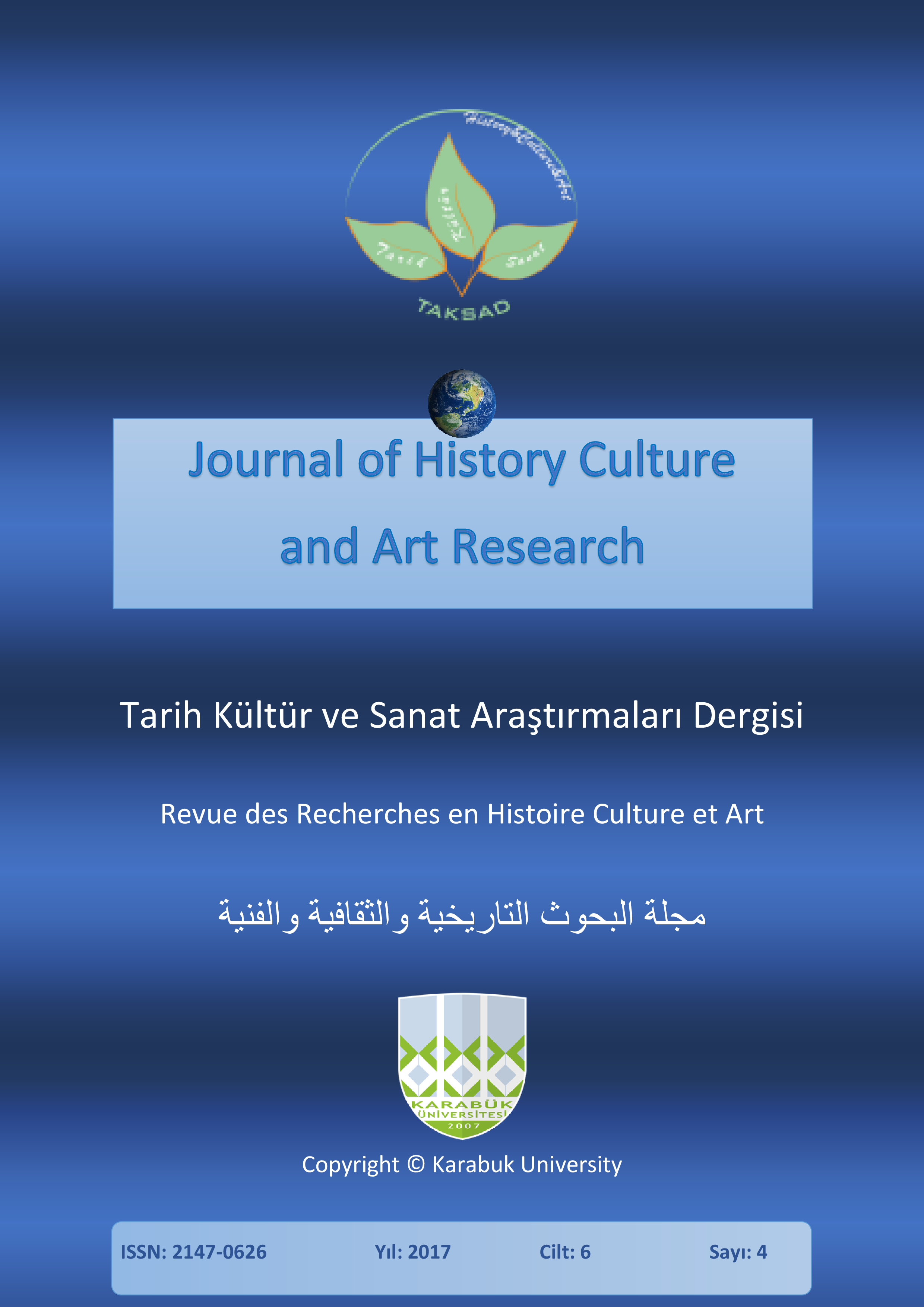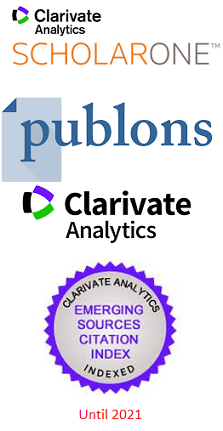Are We Destroying the Space That Nurtures and Embraces Us? Eco-critical Reading of Environmental Pollution in Kelly Roper’s Selected Poems
DOI:
https://doi.org/10.7596/taksad.v6i4.931Anahtar Kelimeler:
Industrialisation- Pollution- Ecosystem- Eco-criticism- Human health.Özet
This paper examines in the selected poems of Kelly Roper from different points of view how the pollution problem seriously risks human life. In so doing, it is divided into two parts. First, the paper accounts for what eco-criticism is, how it developed and then how it deals with the relationship between literature and environment in general, between literature and environmental pollution in particular. Secondly, it tries to show the downside impact of industrialization on the environment and then identify the pollution problem and the types of pollution from different angles in Roper’s selected poems - A Choking Sky, The Stream Where I Played, Glimpse of a Polluted Future, and Perspective on Pollution. In these poems, she, as the paper argues, compares and contracts the condition of the environmental space in the past with that in the present, and she strives not only to raise awareness of how human being has devastated his beautiful environment by polluting it day by day but also to teach us what we should do in the future to protect the environment from the pernicious pollution and create a clean, liveable space for living.
Referanslar
Babones, S. (2017, February 20). Red Alert for China's pollution protesters. Aljazeera. Retrieved from http://www.aljazeera.com/indepth/opinion/2017/02/red-alert-china-pollution-protesters-170217111717375.html
Bate, J. (1991). Romantic ecology: Wordsworth and the environmental tradition. London: Routledge.
Buell, L. (1986). New England Literary Culture. From Revolution Through Renaissance. Cambridge: Cambridge University Press.
Buell, L. (1995). The Environmental Imagination: Thoreau, Nature Writing, and the Formation of American Culture. England: Harvard University Press.
Buell, L. (2005). The future of environmental criticism: Environmental crisis and environmental imagination. Malden: Blackwell.
Campbell, S. (1996). The land and language of desire. In C. Glotfelty, & H. Fromm (Eds.), the ecocriticism reader: Landmarks in literary ecology (pp. 124-136). Athens: University of Georgia Press.
Cherniwchan, J. (2012). Economic growth, industrialization, and the environment. Resource and Energy Economics, 34, 442–467.
Clark, T. (2011). The Cambridge Introduction to Literature and the Environment. New York: Cambridge UP.
Coupe, E. L. (2000). The green studies reader: From romanticism to ecocriticism. London: Routledge.
Dearling, A. (2006). Environmentalism. In Leonard, T. M. (Ed.), Encyclopaedia of the Developing World. New York and London: Routledge, 572-575.
Dhami, J. K.; Singh, H. & Gupta, M. (2013). Industrialization At The Cost Of Environment Degradation- A Case of Leather and Iron and Steel Industry from Punjab Economy. Innovative Journal of Business and Management, 2 (1), 19 - 21.
Ecocriticism. (n.d.). In Wikipedia. Retrieved March 26, 2017, from https://en.wikipedia.org/wiki/Ecocriticism
Estok, S. C. (2005). Bridging the Great Divide: Ecocritical Theory and the Great Unwashed. ESC, 31(4), 197-209.
Gerrard, G. (2004). Ecocriticism. New York: Routledge.
Gilpin, A. (1996). Dictionary of Environment and Sustainable Development. Chichester: John Wiley and Sons.
Glotfelty, C. (1996). Introduction: Literary Studies in an Age of Environmental Crisis. In C. Glotfelty, & H. Fromm (Eds.), the ecocriticism reader: Landmarks in literary ecology (pp. xv-xxxvii). Athens: University of Georgia Press.
Glotfelty, C. & Fromm, H. (1996). The Eocriticism Reader: Landmarks in Literary Ecology. Athens: The University of Georgia Press.
How Do Factories Pollute the Air? (2015). Retrieved from http://www.livestrong.com/article/177248-how-do-factories-pollute-the-air/
Jones, G. & Jones, G. (1990). Collins Dictionary of Environmental Science (Glasgow: Harper Collins Publishers.
Kroeber, K. (1994). Ecological literary criticism: Romantic imagining and the biology of the mind. New York, NY: Colombia University Press.
Leonard, T. M. (Ed.). (2006). Encyclopaedia of the Developing World. New York and London: Routledge.
Magsi, H. (2015). Industrialization, Environment and Pollution. The Diplomatic Insight, 24-26. Retrieved from www.researchgate.net/publication/270899735_Industrialization_Environment_and_Pollution
Miah, M. M. (2012). Wordsworth’s Nature Poetry: An Eco-Scientific Perspective. Sino-US English Teaching, 9 (12), 1793-1800.
Morton, T. (2017). Romantic Disaster Ecology: Blake, Shelley, Wordsworth. Retrieved from https://www.rc.umd.edu/praxis/disaster/HTML/praxis.2012.morton.html
Murguia, D. (2006). Pollution, Industrial. In Leonard, T. M. (Ed.), Encyclopaedia of the Developing World. New York and London: Routledge, 1288-1292.
Porritt, J. & Winner, D. (1988). The Coming of the Greens. Glasgow: Fontana/Collins.
Ramazani, A. & Bazregarzadeh, E. (2014). An Ecocritical Reading of William Wordsworth’s Selected Poems. English Language and Literature Studies, 4 (1), 1-9.
Rigby, K. (2002). Ecocriticism. In J. Wolfreys (Ed.), Introducing criticism at the 21st century (pp. 151-178). Edinburgh: Edinburgh University Press.
Roper, K. (n.d.). Poems About Pollution. Retrieved from http://greenliving.lovetoknow.com/Poems_About_Pollution
Rueckert, W. (1996). Literature and Ecology: An Experiment in Ecocriticism. In C. Glotfelty, & H. Fromm (Eds.), the ecocriticism reader: Landmarks in literary ecology (pp. 105-123). Athens: University of Georgia Press.
Tošić, J. (2006). Ecocriticism–Interdisciplinary Study of Literature and Environment. FACTA UNIVERSITATIS: Series: Working and Living Environmental Protection, 3 (1). 43 – 50.
Williams, R. (1978). The country and the city. New York: Oxford University Press.
Woodford, C. (2016). Water Pollution: an Introduction. Retrieved from http://www.explainthatstuff.com/waterpollution.html
Worster, D. (1977). Nature’s economy: The roots of ecology. San Francisco: Sierra Club Books.
Yang, L.; Yuan, S. & Sun, L. (1975). The Relationships between Economic Growth and Environmental Pollution Based on Time Series Data An Empirical Study of Zhejiang Province. Journal of Cambridge Studies, 7 (1), 33-47.
İndir
Yayınlanmış
Nasıl Atıf Yapılır
Sayı
Bölüm
Lisans
Tarih Kültür ve Sanat Araştırmaları Dergisi'nde yayımlanan tüm çalışmalar Creative Commons 4.0 CC-BY lisansı ile lisanslanmıştır.
Bunları yapmakta özgürsünüz:
- Bu eseri her boyut ve formatta paylaşabilir — kopyalayabilir ve çoğaltabilirsiniz.
- Materyalden Adapte et — karıştır, aktar ve eserin üzerine inşa et
- her türlü amaç için, ticari amaç da dahil
Alttaki şartlar altında:
Atıf — uygun bilgiyi, lisansa linki, and ve değişiklik yapıldıysa değişiklik bilgisinivermelisiniz. Sizi veya kullanımınızı lisansörün onayladığı bilgisini içermemek kaydıyla, size uygun şekilde bu işlemleri gerçekleştirebilirsiniz.
AynıLisanslaPaylaş — Eğer materyali karıştırdınızsa, aktardınızsa ya da materyalin üzerine çalıştınızsa, ancak aynı lisans ile dağıtabilirsiniz.
- Ek sınırlamalar yoktur — Lisansın izin verdiği hakları başkaları üzerinde kanunlarla ya da teknolojiyikullanarak sınırlayamazsınız.







